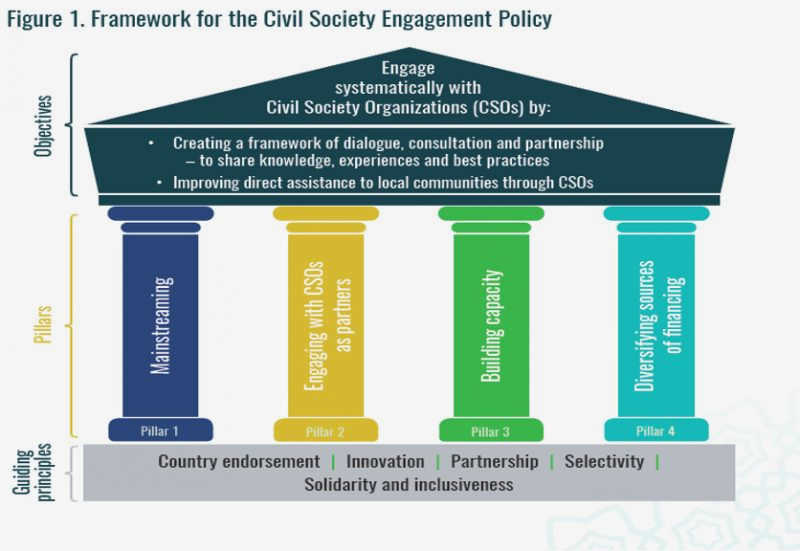Civil society plays a crucial role in any democratic society. It is the foundation of a healthy and vibrant democracy, and it ensures that the voices of citizens are heard and their rights protected. However, building and sustaining strong civil society organizations can be a challenging task. They often face numerous obstacles and constraints that hinder their effectiveness and limit their impact.
One strategy for empowering civil society organizations is to provide them with the necessary resources and support. This can include financial support, training and capacity-building programs, and access to networking and collaboration opportunities. By investing in the development of these organizations, it becomes possible to strengthen their ability to advocate for social justice, promote human rights, and drive positive change.
Another crucial strategy is to create an enabling environment for civil society organizations to operate. This involves ensuring the protection of freedom of expression, assembly, and association, as well as the right to access information. Governments can play a significant role in creating this enabling environment by enacting and enforcing legislation that protects and promotes the work of civil society organizations.
Furthermore, fostering partnerships between civil society organizations and other sectors, such as the business sector and academia, can also be an effective strategy for building stronger organizations. These partnerships can provide civil society organizations with access to expertise, resources, and new perspectives, thereby enhancing their capacity to address complex social issues and achieve their goals.

In conclusion, empowering civil society organizations is essential for building stronger and more effective organizations. By providing them with the necessary resources, creating an enabling environment, and fostering partnerships, it becomes possible to strengthen their capacity to advocate for positive change and contribute to the development of democratic societies.
Empowering Civil Society
In today’s globalized and interconnected world, civil society organizations play a vital role in promoting democracy, human rights, and social justice. Empowering civil society is essential for building stronger and more resilient organizations that can effectively address the pressing challenges of our time.

Effective governance and accountability: Empowering civil society organizations involves fostering a culture of transparency, accountability, and good governance. This includes promoting participatory decision-making processes, enhancing the capacity of organizations to manage resources efficiently, and ensuring that leaders are accountable to their constituents.
Capacity building and skills development: To empower civil society, it is crucial to invest in capacity building and skills development for organizational leaders, staff, and volunteers. This can include training programs, workshops, and mentorship opportunities to enhance technical skills, leadership abilities, and strategic thinking.
Access to resources and funding: Civil society organizations often face challenges in accessing financial resources to sustain their activities. Empowering civil society involves facilitating access to funding and resources through partnerships with donors, governments, and other stakeholders. This can include providing support for fundraising efforts, facilitating networking opportunities, and advocating for policies that promote philanthropy and resource mobilization.
Collaboration and networking: Strengthening civil society organizations requires building networks and fostering collaboration with other like-minded organizations, both locally and internationally. This can facilitate knowledge sharing, resource pooling, and collective action on common issues. Platforms for networking and collaboration, such as conferences, forums, and online communities, can play a crucial role in empowering civil society.
Advocacy and policy influence: Empowering civil society also involves equipping organizations with the skills and tools to engage in effective advocacy and influence policy-making processes. This can include providing training on policy analysis, strategic communication, and engaging with policymakers. Civil society organizations can play a critical role in shaping policies that advance the interests of their constituents and contribute to social change.
By empowering civil society organizations, we can create an enabling environment for their work, promote social inclusiveness, and build stronger organizations capable of driving change and contributing to sustainable development.
Strategies for Building Stronger Organizations
Building a strong and effective organization is key to empowering civil society. Here are some strategies that can help organizations achieve this:

1. Effective Leadership
Having strong and capable leaders is crucial for the success of any organization. These leaders should have a clear vision, inspire others, and make informed decisions. They should also be able to effectively communicate with stakeholders and adapt to changing circumstances.
2. Strategic Planning
Developing a strategic plan is essential for organizations to define their goals, allocate resources, and implement strategies. This involves conducting a thorough analysis of the organization’s strengths, weaknesses, opportunities, and threats. It also requires setting clear objectives and creating action plans that outline the steps required to achieve those goals.
3. Capacity Building
Investing in the capacity building of staff and volunteers can greatly enhance an organization’s effectiveness. This includes providing training, mentoring, and professional development opportunities to enhance skills and knowledge. It also involves fostering a culture of continuous learning and improvement within the organization.
4. Collaboration and Networking
Collaboration and networking with other organizations and stakeholders can lead to increased resources, knowledge sharing, and collective action. Building strong partnerships and alliances can help organizations leverage their strengths and tackle complex issues more effectively.
5. Monitoring and Evaluation
Regularly monitoring and evaluating the organization’s activities and outcomes is essential for learning and improvement. This involves setting measurable indicators, collecting data, and analyzing the results to assess progress and identify areas for improvement. It also includes conducting external evaluations to gain objective insights and feedback.
6. Financial Sustainability
Ensuring financial sustainability is vital for the long-term success of an organization. This requires diversifying funding sources, developing strong fundraising strategies, and managing resources efficiently. It also involves building strong relationships with donors and stakeholders to secure ongoing support.
7. Effective Communication
Clear and effective communication is essential for building strong relationships internally and externally. Organizations should establish transparent communication channels, listen to stakeholders’ feedback, and communicate their mission, goals, and impact effectively. This includes using a variety of communication tools and techniques, such as social media, newsletters, and events.
8. Embracing Innovation
Embracing innovation and adopting new technologies can help organizations stay relevant and adapt to changing needs and circumstances. This includes exploring new approaches, experimenting with new ideas, and leveraging technology to streamline processes, enhance efficiency, and reach a wider audience.
9. Building a Diverse and Inclusive Organization
Building a diverse and inclusive organization is essential for promoting equity, representation, and participation. This involves creating a welcoming and inclusive environment where individuals from different backgrounds, cultures, and perspectives feel valued and empowered. It also requires implementing policies and practices that promote diversity and address biases and discrimination.
Enhancing Leadership Skills
A strong and effective civil society relies on strong leadership skills. Leaders in civil society organizations play a crucial role in driving change, inspiring others, and mobilizing resources. To enhance their leadership skills, it is important for individuals to engage in continuous learning and development.
1. Self-awareness: Effective leaders have a deep understanding of their own strengths, weaknesses, and personal values. They are aware of their impact on others and constantly strive to improve themselves. Developing self-awareness can be done through self-reflection, seeking feedback from others, and participating in leadership development programs.
2. Communication: Strong leadership requires effective communication skills. Leaders need to be able to articulate their vision and goals clearly and inspire others to action. They should also be skilled listeners, able to understand and empathize with the perspectives and needs of others. Developing communication skills can involve taking public speaking courses, practicing active listening, and seeking opportunities to engage in meaningful dialogue.
3. Collaboration: Collaboration is essential in civil society organizations, as leaders often need to work with diverse stakeholders to achieve common goals. Effective leaders understand the value of collaboration and are skilled in building and managing partnerships. They can foster a culture of teamwork and empower others to contribute their expertise. Building collaboration skills can involve attending workshops on negotiation and conflict resolution, building relationships with other organizations, and practicing inclusive decision-making.

4. Strategic thinking: Leaders in civil society organizations need to have a strategic mindset, able to analyze complex problems, identify opportunities, and develop innovative solutions. They should be able to think critically and make informed decisions based on data and evidence. Enhancing strategic thinking skills can involve taking courses on problem-solving, staying informed about emerging trends and best practices, and seeking mentorship from experienced leaders.
5. Resilience: Leadership in civil society organizations can be challenging and demanding. Effective leaders are resilient, able to adapt to change, overcome obstacles, and bounce back from setbacks. They are able to maintain their motivation and inspire others even in the face of adversity. Building resilience can involve practicing self-care, seeking support from a mentor or coach, and developing coping strategies to manage stress.
In conclusion, enhancing leadership skills is crucial for building stronger civil society organizations. By focusing on self-awareness, communication, collaboration, strategic thinking, and resilience, leaders can inspire others, drive change, and create a thriving civil society. Continuous learning and development are key to becoming an effective leader.
Effective Communication Strategies
1. Clear and concise messaging
One of the most important aspects of effective communication is ensuring that your message is clear and concise. Avoid using jargon or technical terms that may be difficult for your audience to understand. Instead, use simple and straightforward language that conveys your main points.
2. Active listening
Effective communication is a two-way process, and active listening is an essential part of it. When engaging with others, make sure to give them your full attention and listen attentively to their ideas and concerns. This will help you better understand their perspective and ensure that you can respond appropriately.
3. Use a variety of communication channels
Not everyone absorbs information in the same way, so it’s important to use a variety of communication channels to reach your audience. This can include email, social media, newsletters, and in-person meetings. By using different channels, you can ensure that your message reaches a wider audience and is more likely to be understood.
4. Tailor your message to your audience
Knowing your audience is key to effective communication. Consider their background, interests, and knowledge level when crafting your message. By tailoring your communication to the specific needs and preferences of your audience, you can increase the likelihood that your message will resonate with them.
5. Provide regular updates and feedback
Communication is an ongoing process, so it’s important to provide regular updates and seek feedback from your audience. This can help ensure that they stay informed and engaged, and that you can address any questions or concerns they may have. Regular communication also helps build trust and fosters a sense of inclusion within your organization.
6. Foster open and honest communication
Creating a culture of open and honest communication is essential for building strong organizations. Encourage your team members to share their thoughts, ideas, and concerns, and provide a safe and supportive environment for them to do so. This will not only improve teamwork and collaboration but also help identify and address any potential issues or challenges more effectively.
In summary, effective communication is crucial for building stronger organizations. By adopting clear and concise messaging, active listening, using a variety of communication channels, tailoring your message to your audience, providing regular updates and feedback, and fostering open and honest communication, you can enhance the overall effectiveness of your communication strategies.
Building Effective Partnerships
1. Identifying Shared Goals
Building effective partnerships begins with identifying shared goals between organizations. It is crucial for partners to have a common vision and mission to work towards a common objective. This alignment ensures that all parties are working towards the same outcome and have a clear understanding of their role and responsibilities within the partnership.
2. Transparent Communication
Transparent communication is essential in building effective partnerships. Clear and open lines of communication enable partners to share information, concerns, and ideas freely. This transparency helps in building trust and avoids misunderstandings. It is important to establish regular communication channels and maintain effective communication throughout the partnership.
3. Sharing Resources
Partnerships can be strengthened by sharing resources. This includes sharing knowledge, expertise, funding, and physical resources. By pooling together resources, organizations can achieve greater impact and leverage each other’s strengths. The key is to identify complementary resources and find ways to maximize their combined potential.
4. Collaboration and Cooperation
Successful partnerships are built on collaboration and cooperation. This involves working together towards a common goal, sharing responsibilities, and supporting each other’s efforts. Collaboration can take various forms, such as joint projects, shared initiatives, or even merging operations. The key is to foster a spirit of cooperation and a willingness to work together for the greater good.
5. Evaluating and Adapting
Regular evaluation and adaptation are essential for building effective partnerships. It is important to regularly assess the partnership’s progress, identify areas for improvement, and adapt strategies accordingly. This iterative process helps partners stay aligned and ensures that the partnership remains relevant and effective over time.
Overall, building effective partnerships requires a commitment to shared goals, transparent communication, resource sharing, collaboration, and ongoing evaluation. When these elements are in place, organizations can harness the power of partnerships to achieve greater impact and create lasting change.
Collaborating with Government Agencies
Collaborating with government agencies can provide civil society organizations with important resources, support, and legitimacy. By working together, these organizations can leverage their respective strengths and expertise to tackle complex societal issues and drive positive change.
One way to collaborate with government agencies is through partnerships and joint initiatives. Civil society organizations can propose projects that align with government priorities and goals, demonstrating how their work can contribute to larger societal objectives. This can help secure government funding and support for their initiatives, as well as provide access to government resources and networks.
Engaging with government agencies can also help increase the visibility and credibility of civil society organizations. By working alongside government officials and agencies, these organizations can build relationships and establish themselves as trusted and reliable partners in promoting social and political change. This can enhance their ability to attract funding and attract a wider audience for their advocacy and awareness campaigns.
Furthermore, collaborating with government agencies can help civil society organizations navigate complex regulatory frameworks and bureaucratic processes. Government agencies can provide guidance and assistance in areas such as legal compliance, policy development, and advocacy strategies. This can enable civil society organizations to effectively navigate the political landscape and achieve their objectives in a more efficient and impactful manner.
In summary, collaborating with government agencies can provide civil society organizations with numerous benefits, including access to resources, increased legitimacy, and the ability to navigate complex regulatory environments. By leveraging their respective strengths and expertise, these collaborations can drive positive change and contribute to building stronger and more effective civil society organizations.
Engaging Communities
1. Utilizing Social Media Platforms
Engaging communities is crucial for building a strong civil society organization. One effective way to reach and connect with communities is through the use of social media platforms. These platforms provide a valuable opportunity to share information, raise awareness, and mobilize support for various causes.

By creating engaging and informative content, civil society organizations can attract a wider audience and encourage community members to contribute their ideas, resources, and time. Social media can also serve as a platform for dialogue and discussion, allowing organizations to gather valuable feedback and input from the community.
2. Collaborative Decision-Making
Engaging communities in the decision-making process is essential for building strong and sustainable organizations. By involving community members in the decision-making process, organizations can ensure that their actions and initiatives align with the needs and aspirations of the community.
One way to promote collaborative decision-making is through the establishment of community advisory boards or councils. These bodies can provide a space for community representatives to share their perspectives, concerns, and suggestions, and work together with the organization to develop and implement effective strategies and programs.
3. Engaging in Local Events and Activities
An important aspect of community engagement is actively participating in local events and activities. By attending and supporting community events, civil society organizations can demonstrate their commitment to the community and establish strong relationships with community members.
Organizations can organize workshops, educational sessions, or community-driven projects to address local challenges and provide opportunities for community members to learn and grow. This proactive engagement helps to build trust, foster collaboration, and empower the community to take ownership of their own development.
4. Building Partnerships and Networks
Engaging communities also involves establishing partnerships and networks with other civil society organizations, local businesses, government agencies, and community leaders. By building strong connections, organizations can leverage collective resources, expertise, and influence to address common challenges and promote positive change.
Partnerships and networks provide opportunities for organizations to share knowledge, best practices, and resources, and amplify their impact by working collaboratively. These connections can also help to create a supportive ecosystem that nurtures and strengthens civil society organizations and empowers communities.
In conclusion, engaging communities is a vital aspect of building stronger civil society organizations. Through the use of social media platforms, collaborative decision-making, active participation in local events, and building partnerships and networks, organizations can empower communities, mobilize support, and enhance their impact on social change.
Grassroots Mobilization Techniques
Grassroots mobilization techniques play a crucial role in empowering civil society organizations and building stronger communities. These techniques involve organizing and engaging individuals at the local level to create a collective voice and drive social change.
1. Door-to-door canvassing
Door-to-door canvassing is a powerful grassroots mobilization technique that involves volunteers going door-to-door to spread awareness, gather support, and collect signatures for petitions or initiatives. This personal approach allows for direct interaction with community members, which can be effective in building relationships and mobilizing support for a cause.
2. Community organizing
Community organizing is a grassroots mobilization technique that involves bringing together community members to collectively address and take action on issues that affect them. This technique focuses on building relationships, empowering individuals, and fostering a sense of ownership and responsibility within the community. It often includes activities such as town hall meetings, workshops, and collaborative decision-making processes.
3. Social media campaigns
Social media campaigns have become increasingly popular and effective in mobilizing grassroots movements. Organizations can use platforms like Facebook, Twitter, and Instagram to raise awareness, engage with supporters, share success stories, and rally for action. Social media campaigns have the advantage of reaching a large audience quickly and providing opportunities for individuals to become active participants in the movement.
4. Advocacy and lobbying
Advocacy and lobbying involve engaging with policymakers and decision-makers at various levels of government to influence policies, laws, and regulations. Grassroots organizations can mobilize their members to contact legislators, attend public hearings, and participate in advocacy events to push for change. This technique allows for direct engagement with those in power and can have a significant impact on shaping policies that align with the organization’s goals.
In conclusion, grassroots mobilization techniques are essential tools for building stronger civil society organizations and empowering communities. By harnessing the power of personal interactions, community organizing, social media campaigns, and advocacy work, civil society organizations can mobilize individuals, raise awareness, and drive meaningful change at the grassroots level.
Fundraising and Resource Management
In order to build and sustain a strong civil society organization, effective fundraising and resource management strategies are essential. These strategies involve identifying potential donors, developing compelling grant proposals, and managing the resources obtained.
Identifying potential donors
One key aspect of fundraising is identifying potential donors who may be interested in supporting the organization’s mission and goals. This can be done through research and networking, identifying individuals, corporations, foundations, and government agencies that align with the organization’s values and objectives.
Developing compelling grant proposals
Once potential donors have been identified, it is crucial to develop compelling grant proposals that effectively communicate the organization’s mission, goals, and the impact of its work. The proposals should highlight the organization’s unique approach and the benefits of partnering with them. This requires a thorough understanding of the donor’s funding priorities and aligning the proposal accordingly.
Managing obtained resources
After securing funding, effective resource management is essential to ensure that the resources are allocated and used efficiently and effectively. This involves creating a strategic budget, monitoring expenditures, and evaluating the impact of the allocated resources. Proper resource management ensures that the organization remains accountable to its donors and provides transparency in its operations.
In conclusion, fundraising and resource management are vital components of building and sustaining a strong civil society organization. By identifying potential donors, developing compelling grant proposals, and managing obtained resources effectively, organizations can secure the necessary support to achieve their goals and make a lasting impact in their communities.
Strategic Grant Writing
Understanding the Scope of the Project
Before beginning the grant writing process, it is crucial to thoroughly understand the scope of the project and the specific goals that need to be achieved. This includes conducting a comprehensive needs assessment and identifying the target audience or beneficiaries. By clearly defining the scope of the project, grant writers can tailor their proposals and align them with the funding organization’s priorities.
Researching Funding Opportunities
One of the key components of strategic grant writing is conducting thorough research on potential funding opportunities. This involves identifying organizations and foundations that align with the mission and focus of the project. Grant writers should carefully review the guidelines and criteria of each funding opportunity to ensure that their proposal is relevant and has a higher chance of being approved. Additionally, it is important to consider any specific preferences or requirements that the funding organization may have.
Developing a Compelling Proposal
Once the scope of the project has been defined and suitable funding opportunities have been identified, grant writers can begin developing a compelling proposal. This should include a concise and persuasive executive summary that highlights the key objectives, activities, and expected outcomes of the project. The proposal should clearly articulate the problem or need that the project aims to address, and outline the strategies and activities that will be implemented. It is important to include realistic goals, measurable objectives, and an effective evaluation plan to demonstrate the impact and effectiveness of the proposed project.
Budgeting and Sustainability
In addition to the project proposal, grant writers should also develop a comprehensive budget that accurately reflects the costs associated with the project. The budget should be realistic and include detailed expense categories, as well as a justification for each expense. Grant writers should also address the sustainability of the project by outlining a plan for long-term funding or resource generation beyond the grant period. This can involve exploring alternative funding sources, partnerships, or revenue-generating activities to ensure the continuity and success of the project beyond the initial grant funding.
Submitting the Proposal
Once the proposal has been developed and reviewed, grant writers should carefully follow the submission guidelines provided by the funding organization. This may involve submitting the proposal online, by mail, or through a specific grant application portal. It is important to submit the proposal before the deadline and to carefully review all the required documents and supporting materials. Grant writers should also maintain open communication with the funding organization, responding promptly to any requests for additional information or clarification.
In conclusion, strategic grant writing involves understanding the scope of the project, researching funding opportunities, developing a compelling proposal, budgeting and ensuring sustainability, and submitting the proposal according to the specified guidelines. By following these steps, organizations can increase their chances of securing grant funding and successfully implementing their projects.
Advocacy and Policy Influence
Advocacy and policy influence play a crucial role in empowering civil society organizations (CSOs) to bring about social and political change. Through advocacy, CSOs can raise awareness about issues, promote the rights and needs of marginalized communities, and advocate for policy changes that address these issues.
One effective strategy for advocacy is lobbying government officials and policymakers. CSOs can engage in direct communication with decision-makers to present their concerns, propose policy solutions, and influence the decision-making process. This can include attending meetings, submitting written recommendations, and organizing public campaigns to mobilize public support.
Moreover, civil society organizations can also engage in coalition building to amplify their advocacy efforts. By forming partnerships and alliances with other like-minded organizations, CSOs can leverage collective strength and combine resources to advocate for common goals. This can involve joint public statements, coordinated advocacy campaigns, and shared research and analysis.
An important aspect of advocacy and policy influence for CSOs is conducting research and analysis to support their arguments and proposals. By collecting data, conducting surveys, and analyzing policy documents, CSOs can present evidence-based arguments to advocate for their cause. This can help to establish credibility and strengthen the impact of their advocacy efforts.
To effectively advocate for policy change, civil society organizations also need to engage in strategic communication. This involves crafting clear and compelling messages, targeting key stakeholders, and using a variety of communication channels such as social media, traditional media, and public events to make their voices heard. Effective communication plays a critical role in mobilizing public support and influencing public opinion.
In conclusion, advocacy and policy influence are powerful tools for empowering civil society organizations to bring about social change. By engaging in lobbying, coalition building, research and analysis, and strategic communication, CSOs can effectively advocate for policy changes that address the needs and rights of marginalized communities and contribute to a more just and equitable society.
Effective Lobbying Strategies
1. Build strong relationships
One of the most effective lobbying strategies is to build strong relationships with key decision-makers. This includes politicians, policymakers, and influential stakeholders who have the power to make or influence decisions. By establishing personal connections, civil society organizations can gain access to decision-making processes and have their voices heard.
2. Develop a targeted approach
Effective lobbying requires a targeted approach. Civil society organizations should identify specific issues or policies that they wish to address and focus their efforts on those areas. By narrowing down their focus, organizations can allocate their resources more effectively and increase their chances of success.
3. Conduct research and gather data
In order to lobby effectively, organizations need to have a solid understanding of the issues at hand. This includes conducting research, gathering data, and analyzing relevant information. By having evidence-based arguments, organizations can make a stronger case for their cause and increase their credibility.
4. Mobilize grassroots support
An effective lobbying strategy involves mobilizing grassroots support. This can include organizing public awareness campaigns, engaging with local communities, and rallying support from individuals who are directly affected by the issues at hand. By creating a strong and vocal base of support, civil society organizations can put pressure on decision-makers to take action.
5. Utilize different lobbying tactics
Effective lobbying strategies involve using a variety of tactics. This can include direct lobbying, such as meeting with decision-makers and presenting arguments in person, as well as indirect lobbying, such as media campaigns and public demonstrations. By utilizing different tactics, organizations can maximize their impact and reach a wider audience.
6. Collaborate with other organizations
Collaboration is key to effective lobbying. By joining forces with other civil society organizations who share similar goals or values, organizations can amplify their voices and increase their collective impact. By working together, organizations can pool their resources, share expertise, and leverage their networks to achieve common objectives.
7. Stay informed and adapt
In the fast-paced world of policy-making, it is crucial for organizations to stay informed and adapt their strategies accordingly. This includes keeping up-to-date with changing policies, political landscapes, and emerging trends. By staying informed and adapting their approaches, civil society organizations can remain relevant and maximize their chances of success.





